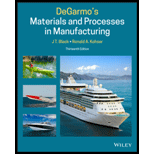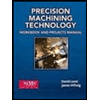
Degarmo's Materials And Processes In Manufacturing
13th Edition
ISBN: 9781119492825
Author: Black, J. Temple, Kohser, Ronald A., Author.
Publisher: Wiley,
expand_more
expand_more
format_list_bulleted
Concept explainers
Textbook Question
Chapter 5, Problem 1RQ
What is heat treatment?
Expert Solution & Answer
To determine
The term heat treatment.
Explanation of Solution
Heat treatment is defined as the thermal process which helps in increasing the strength of a material. It includes controlled heating and cooling in order to change the structure and properties of the material.
The material can be prepared as weak, brittle or ductile as per the requirement of the manufacturer. Heat transfer is used for altering the physical and mechanical properties of the material like toughness, strength and machinability, etc. It can be done using welding or hot forming.
Want to see more full solutions like this?
Subscribe now to access step-by-step solutions to millions of textbook problems written by subject matter experts!
Students have asked these similar questions
What is heat treatment?
Differentiate annealing and tempering heat treatment processes.
Explain with neat sketch, “Anodizing” heat treatment process.
Chapter 5 Solutions
Degarmo's Materials And Processes In Manufacturing
Ch. 5 - What is heat treatment?Ch. 5 - What types of properties can be altered through...Ch. 5 - Why should people performing hot forming or...Ch. 5 - What is the broad goal of the processing heat...Ch. 5 - Why might equilibrium phase diagrams be useful...Ch. 5 - What are the A1, A3, and Acm lines?Ch. 5 - What are some possible objectives of annealing...Ch. 5 - Why might it be important to include a preceding...Ch. 5 - Describe the cooling conditions of a full anneal.Ch. 5 - Why are the hypereutectoid steels not...
Ch. 5 - Although full anneals often produce the softest...Ch. 5 - What is the major process difference between full...Ch. 5 - Although normalizing is less expensive than a full...Ch. 5 - Prob. 14RQCh. 5 - What types of steel would be candidates for a...Ch. 5 - How might steel composition influence the...Ch. 5 - Other than increasing strength, for what three...Ch. 5 - What are the six major mechanisms that can be used...Ch. 5 - Prob. 19RQCh. 5 - What is required for a metal to be a candidate for...Ch. 5 - What are the three steps in an age�hardening...Ch. 5 - What is the difference between a coherent...Ch. 5 - What is overaging? Why does strength decrease?Ch. 5 - Describe the various aging responses (maximum...Ch. 5 - What is the difference between natural and...Ch. 5 - Why might naturally aging aluminum rivets be...Ch. 5 - Why is it important not to expose precipitation...Ch. 5 - Why is it more difficult to understand the...Ch. 5 - What types of heating and cooling conditions are...Ch. 5 - What are the stable equilibrium phases for steels...Ch. 5 - What are some nonequilibrium structures that...Ch. 5 - Prob. 32RQCh. 5 - What is the major factor that influences the...Ch. 5 - For a given steel, describe the relative strengths...Ch. 5 - Most structure changes proceed to completion over...Ch. 5 - What is retained austenite, and why is it an...Ch. 5 - What types of steels are more prone to retained...Ch. 5 - Why are martensitic structures usually tempered...Ch. 5 - Why does tempering offer a spectrum of possible...Ch. 5 - In what ways is the quench�and�temper heat...Ch. 5 - What is a C�C�T diagram? Why is it more useful...Ch. 5 - What is the critical cooling rate, and how is it...Ch. 5 - What two features combine to determine the...Ch. 5 - What conditions are used to standardize the quench...Ch. 5 - How do the various locations of a Jominy test...Ch. 5 - How do the data collected from a Jominy test...Ch. 5 - What is the assumption that allows the data from a...Ch. 5 - What is hardenability? How is it different from...Ch. 5 - What capabilities are provided by...Ch. 5 - When selecting a steel for an application, what...Ch. 5 - What are the three stages of liquid quenching?Ch. 5 - What are some of the major advantages and...Ch. 5 - Why does brine provide faster cooling than water?Ch. 5 - Why is an oil quench less likely to produce quench...Ch. 5 - What are some of the attractive qualities of a...Ch. 5 - Prob. 56RQCh. 5 - Prob. 57RQCh. 5 - Prob. 58RQCh. 5 - Prob. 59RQCh. 5 - How might the thermally induced residual stresses...Ch. 5 - Prob. 61RQCh. 5 - Prob. 62RQCh. 5 - Prob. 63RQCh. 5 - What is thermomechanical processing?Ch. 5 - Prob. 65RQCh. 5 - Prob. 66RQCh. 5 - Prob. 67RQCh. 5 - Prob. 68RQCh. 5 - Prob. 69RQCh. 5 - Prob. 70RQCh. 5 - Prob. 71RQCh. 5 - Prob. 72RQCh. 5 - Prob. 73RQCh. 5 - Why does a carburized part have to be further...Ch. 5 - Prob. 75RQCh. 5 - Prob. 76RQCh. 5 - Prob. 77RQCh. 5 - Describe the distinguishing features of a box...Ch. 5 - What are some possible functions of artificial...Ch. 5 - Prob. 80RQCh. 5 - Prob. 81RQCh. 5 - Prob. 82RQCh. 5 - What are some current goals of the heat treatment...Ch. 5 - Prob. 1PCh. 5 - Prob. 2PCh. 5 - Prob. 3PCh. 5 - Prob. 4PCh. 5 - Prob. 5PCh. 5 - Prob. 6PCh. 5 - What problems might be expected if the material on...Ch. 5 - Describe some heat treatment processes or...Ch. 5 - Prob. 1.3CSCh. 5 - Prob. 1.4CSCh. 5 - Prob. 1.5CSCh. 5 - Prob. 1.6CSCh. 5 - Prob. 1.7CSCh. 5 - Prob. 1.8CSCh. 5 - Prob. 2.1CSCh. 5 - Prob. 2.2CSCh. 5 - How would you alter the procedures or policies of...
Knowledge Booster
Learn more about
Need a deep-dive on the concept behind this application? Look no further. Learn more about this topic, mechanical-engineering and related others by exploring similar questions and additional content below.Similar questions
- Enumerate and define the three types of heat treatment.arrow_forwardFor each of the heat treatments and processes below, explain what the process is, how it affects the structure, properties and behaviour of the parent material. A) solution heat treatment of Aluminium/ Copper alloys B) chemical vapour deposition on semiconductor materials C) Hot forging of steelsarrow_forwardCompare normalizing and hardening heat treatment processes .arrow_forward
- 7 what would be the resulting microstructure from heat treatment?arrow_forward1-discribe how manufacturing Process are classified? 2- llustrate the process which work above recrystallization temperature with neat sketch? 3- Discuss the heat treatment process which uses rapid cooling of steel in oil or molten salt bath?arrow_forwardWhat is Thermal Nox?arrow_forward
- Comparison of treatment processes (annealing, normalizing, hardening and tempering) according to heating and cooling, microstructure and mechanical propertiesarrow_forwardHeat treatment is the controlled heating and cooling of metals to alter their physical and mechanical properties without changing the product shape. When performing the cooling step of the tempering process, knife makers have used material such as clay to cover portions of the blade to slow the cooling rate of the covered steel. Why may this technique be beneficial for making a sword which holds a sharp edge while remaining flexible enough to withstand the forces subjected to it in battle?arrow_forwardWhat is a complementary solutin?arrow_forward
arrow_back_ios
SEE MORE QUESTIONS
arrow_forward_ios
Recommended textbooks for you
 Welding: Principles and Applications (MindTap Cou...Mechanical EngineeringISBN:9781305494695Author:Larry JeffusPublisher:Cengage Learning
Welding: Principles and Applications (MindTap Cou...Mechanical EngineeringISBN:9781305494695Author:Larry JeffusPublisher:Cengage Learning Precision Machining Technology (MindTap Course Li...Mechanical EngineeringISBN:9781285444543Author:Peter J. Hoffman, Eric S. Hopewell, Brian JanesPublisher:Cengage Learning
Precision Machining Technology (MindTap Course Li...Mechanical EngineeringISBN:9781285444543Author:Peter J. Hoffman, Eric S. Hopewell, Brian JanesPublisher:Cengage Learning

Welding: Principles and Applications (MindTap Cou...
Mechanical Engineering
ISBN:9781305494695
Author:Larry Jeffus
Publisher:Cengage Learning

Precision Machining Technology (MindTap Course Li...
Mechanical Engineering
ISBN:9781285444543
Author:Peter J. Hoffman, Eric S. Hopewell, Brian Janes
Publisher:Cengage Learning
Heat Transfer [Conduction, Convection, and Radiation]; Author: Mike Sammartano;https://www.youtube.com/watch?v=kNZi12OV9Xc;License: Standard youtube license